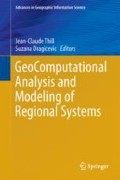Abstract
Spatial optimization is commonly used for political (or electoral) districting problems. Although an exact approach can be used, heuristic methods have often been used due to the complexity of political districting problems and their multi-criteria nature. However, heuristic approaches may not produce consistent results and may vary in solution quality. This paper focuses on the development of a robust heuristic method for political districting problems, specifically incorporating existing physical barriers in combination with population, contiguity, and compactness of the resulting districts. An application for legislative election districts in Seoul, South Korea shows that the proposed method produces prominent and robust results compared to generic meta-heuristic approaches.
Access this chapter
Tax calculation will be finalised at checkout
Purchases are for personal use only
References
Armstrong MP, Lolonis P, Honey R (1993) A spatial decision support system for school redistricting. J Urban Reg Inf Syst Assoc 5:40–52
Kim H, Chun Y, Kim K (2015) Delimitation of functional regions using a p-regions problem approach. Int Reg Sci Rev 38(3):235–263. doi:10.1177/0160017613484929
Openshaw S, Rao L (1995) Algorithms for reengineering 1991 census geography. Environ Plan A 27:425–446
D’Amico SJ, Wang S-J, Batta R, Rump CM (2002) A simulated annealing approach to police district design. Comput Oper Res 29:667–684
Cutter SL (ed) (2001) American hazardscapes: the regionalization of hazards and disasters. Joseph Henry Press, Washington, DC
Barkan JD, Densham PJ, Rushton G (2006) Space matters: designing better electoral systems for emerging democracies. Am J Polit Sci 50:926–939
Fryer RG Jr, Holden R (2011) Measuring the compactness of political districting plans. J Law Econ 54(3):493–535
Ricca F, Scozzari A, Simeone B (2011) Political districting: from classical models to recent approaches. 4OR 9:223–254
Webster GR (1997) The potential impact of recent supreme court decisions on the use of race and ethnicity in the redistricting process. Cities 14(1):13–19
Bozkaya B, Erkut E, Laporte G (2003) A tabu search heuristic and adaptive memory procedure for political districting. Eur J Oper Res 144:12–26
Garfinkel RS, Nemhauser GL (1970) Optimal political districting by implicit enumeration techniques. Manag Sci 16:495–508
Hess SW, Weaver JB, Siegfelat HJ, Whelan JN, Zitlau PA (1965) Nonpartisan political redistricting by computer. Oper Res 13(6):998–1006
MacMillan W, Pierce T (1994) Optimization modeling in a GIS framework: the problem of political redistricting. In: Fotheringham S, Rogerson P (eds) Spatial analysis and GIS. Taylor and Francis, London, pp 221–246
Bação F, Lobo V, Painho M (2005) Applying genetic algorithms to zone-design. Soft Comput 9:341–348
Forman SL, Yue Y (2003) Congressional districting using a TSP-based genetic algorithm. Lect Notes Comput Sci 2724:2072–2083
Browdy M (1990) Simulated annealing: an improved computer model for political redistricting. Yale Law Policy Rev 8(1):163–179
Williams JC (1995) Political redistricting: a review. Pap Reg Sci 74:13–40
Mills G (1967) The determination of local government electoral boundaries. Oper Res Q 18:243–255
Segal M, Weinberger DB (1977) Turfing. Oper Res 25(3):367–386
George JA, Lamar BW, Wallace CA (1997) Political district determination using large-scale network optimization. Socio Econ Plan Sci 31(1):11–28
Zoltners AA, Sinha P (1983) Sales territory alignment: a review and model. Manag Sci 29:1237–1256
Duque JC, Ramos R, Surinach J (2007) Supervised regionalization methods: a survey. Int Reg Sci Rev 30(3):195–220
Shirabe T (2005) A model of contiguity for spatial unit allocation. Geogr Anal 37(1):2–16
Duque JC, Church RL, Middleton RS (2011) The p-regions problem. Geogr Anal 43:104–126
Fischer MM (1980) Regional taxonomy: a comparison of some hierarchic and non-hierarchic strategies. Reg Sci Urban Econ 10:503–537
Masser I, Scheurwater J (1980) Functional regionalisation of spatial interaction data: an evaluation of some suggested strategies. Environ Plan A 12(12):1357–1382
Openshaw S, Wymer C (1995) Classifying and regionalizing census data. In: Openshaw S (ed) Census users handbook. GeoInformation International, Cambridge, pp 239–270
Openshaw S (1973) A regionalisation program for large data sets. Comput Appl 3(4):136–147
Glover F (1989) Tabu search-part I. ORSA J Comp 1(3):190–206
Liittschwager J (1973) The Iowa redistricting system. Ann N Y Acad Sci 219:221–235
Nagel S (1965) Simplified bipartisan computer redistricting. Stanford Law Rev 17(5):863–899
Openshaw S (1977) A geographical solution to scale and aggregation problems in region-building, partition and spatial modeling. Trans Inst Br Geogr 2(4):459–472
Blais M, Lapierre S, Laporte G (2003) Solving a home-care districting problem in an urban setting. J Oper Res Soc 54(11):1141–1147
Duque JC, Anselin L, Rey SJ (2012) The max-p-regions problem. J Reg Sci 52(3):397–419
Ricca F, Simeone B (2008) Local search algorithms for political districting. Eur J Oper Res 189:1409–1426
Wei BC, Chai WY (2004) A multiobjective hybrid metaheuristic approach for GIS-based spatial zoning model. JMMA 3:245–261
Goldern B, Skiscim C (1986) Using simulated annealing to solve routing and location problems. Nav Res Logist Q 33:264–280
MacMillan W (2001) Redistricting in a GIS environment: an optimization algorithm using switching-points. J Geogr Syst 3:167–180
Young HP (1988) Measuring the compactness of legislative districts. Legis Stud Quart 13(1):105–115.
Kirkpatrick S, Gelatt DC, Vecchi MP (1983) Optimization by simulated annealing. Science 220(4598):671–680
Sammons R (1978) A simplistic approach to the redistricting problem. In: Masser I, Brown P (eds) Spatial representation and spatial interaction. Martinus Nijhoff, Leiden, pp 71–94
Openshaw S (1978) An optimal zoning approach to the study of spatially aggregated data. In: Masser I, Brown P (eds) Spatial representation and spatial interaction. Martinus Nijhoff, Leiden, pp 95–113
Kim MJ, Kim K (2013) Spatial optimization approaches to redistricting for National Assembly election: a case study on Yongin city. J Korean Geogr Soc 48(3):1–15
Author information
Authors and Affiliations
Corresponding author
Editor information
Editors and Affiliations
Rights and permissions
Copyright information
© 2018 Springer International Publishing AG
About this chapter
Cite this chapter
Kim, K., Chun, Y., Kim, H. (2018). A Robust Heuristic Approach for Regionalization Problems. In: Thill, JC., Dragicevic, S. (eds) GeoComputational Analysis and Modeling of Regional Systems. Advances in Geographic Information Science. Springer, Cham. https://doi.org/10.1007/978-3-319-59511-5_16
Download citation
DOI: https://doi.org/10.1007/978-3-319-59511-5_16
Published:
Publisher Name: Springer, Cham
Print ISBN: 978-3-319-59509-2
Online ISBN: 978-3-319-59511-5
eBook Packages: Earth and Environmental ScienceEarth and Environmental Science (R0)

